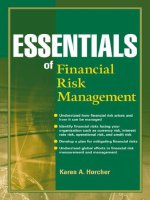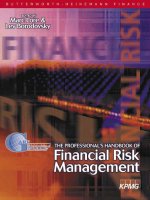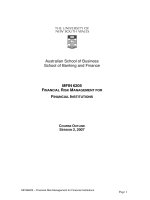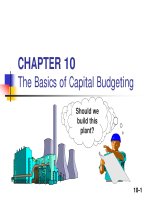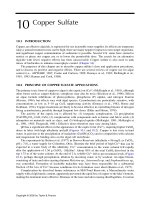Elements of financial risk management chapter 10
Bạn đang xem bản rút gọn của tài liệu. Xem và tải ngay bản đầy đủ của tài liệu tại đây (1.45 MB, 86 trang )
1
Option Pricing
Elements of
Financial Risk Management
Chapter 10
Peter Christoffersen
Elements of Financial Risk Management Second Edition © 2012 by Peter Christoffersen
Overview
2
• In this chapter we derive a no-arbitrage relationship between put
and call prices on same underlying asset
• Summarize binomial tree approach to option pricing
• Establish an option pricing formula under simplistic assumption
that daily returns on the underlying asset follow a normal
distribution with constant variance
• Extend the normal distribution model by allowing for skewness and
kurtosis in returns
• Extend the model by allowing for time-varying variance relying on
the GARCH models
• Introduce the ad hoc implied volatility function (IVF) approach to
option pricing.
Elements of Financial Risk Management Second Edition © 2012 by Peter Christoffersen
Basic Definitions
3
• An European call option gives the owner the right but not the
obligation to buy a unit of the underlying asset days from now at
the price X
•
is the number of days to maturity
• X is the strike price of the option
• c is the price of the European option today
• St is the price of the underlying asset today
•
is the price of the underlying at maturity
Elements of Financial Risk Management Second Edition © 2012 by Peter Christoffersen
Basic Definitions
4
• A European put option gives the owner the option the right to sell a
~ now at the price X
unit of the underlying asset
days from
T
• p denotes the price of the European put option today
• The European options restricts the owner from exercising the
option before the maturity date
• American options can be exercised any time before the maturity
date
• Note that the number of days to maturity is counted is calendar
days and not in trading days.
~
• A standard year has 365 calendar days but onlyTaround 252 trading
days.
Elements of Financial Risk Management Second Edition © 2012 by Peter Christoffersen
Basic Definitions
5
• The payoffs (shown in Figure 10.1) are drawn as a function of the
hypothetical price of the underlying asset at maturity of the option,
• Mathematically, the payoff function for a call option is
• and for a put option it is
• Note the linear payoffs of stocks and bonds and the
nonlinear payoffs of options from Figure 10.1
• We next consider the relationship between European call
and put option prices
Elements of Financial Risk Management Second Edition © 2012 by Peter Christoffersen
Figure 10.1: Payoff as a Function of the Value of the
Underlying Asset at Maturity Call Option, Put
Option, Underlying Asset, Risk-Free Bond
Elements of Financial Risk Management Second Edition © 2012 by Peter Christoffersen
6
Basic Definitions
7
• Put-call parity does not rely on any particular option pricing
model. It states
• It can be derived from considering two portfolios:
• One consists of underlying asset and put option and
another consists of call option, and a cash position equal to
the discounted value of the strike price.
• Whether underlying asset price at maturity,
ends up
below or above strike price X; both portfolios will have
same value, namely
, at maturity
• Therefore they must have same value today, otherwise
arbitrage opportunities would exist
Elements of Financial Risk Management Second Edition © 2012 by Peter Christoffersen
Basic Definitions
• The portfolio values underlying this argument are shown in the
following
Elements of Financial Risk Management Second Edition © 2012 by Peter Christoffersen
8
Basic Definitions
9
• put-call parity suggests how options can be used in risk
management
• Suppose an investor who has an investment horizon of days owns
a stock with current value St
• Value of the stock at maturity of the option is
which in the worst
case could be zero
• An investor who owns the stock along with a put option with a
strike price of X is guaranteed the future portfolio value
, which is at least X
• The protection is not free however as buying the put option requires
paying the current put option price
Elements of Financial Risk Management Second Edition © 2012 by Peter Christoffersen
10
Option Pricing Using Binomial Trees
• We begin by assuming that the distribution of the future price of the
underlying risky asset is binomial
• This means that in a short interval of time, the stock price can only
take on one of two values, up and down
• Binomial tree approach is able to compute the fair market value of
American options, which are complicated because early exercise is
possible
Elements of Financial Risk Management Second Edition © 2012 by Peter Christoffersen
Option Pricing Using Binomial Trees
11
• The binomial tree option pricing method will be illustrated using
the following example:
• We want to find the fair value of a call and a put option with three
months to maturity
• Strike price of $900.
• The current price of the underlying stock is $1,000
• The volatility of the log return on the stock is 0.60 or 60% per year
corresponding to
per calendar day
Elements of Financial Risk Management Second Edition © 2012 by Peter Christoffersen
12
Step 1: Build the Tree for the Stock Price
• In our example we will assume that the tree has two steps during
the three-month maturity of the option
• In practice, a hundred or so steps will be used
• The more steps we use, the more accurate the model price will be
• If the option has three months to maturity and we are building a
tree with two steps then each step in the tree corresponds to 1.5
months
• The magnitude of up and down move in each step reflect a
volatility of
• dt denotes the length (in years) of a step in the tree
Elements of Financial Risk Management Second Edition © 2012 by Peter Christoffersen
13
Step 1: Build the Tree for the Stock Price
• Because we are using log returns a one standard deviation up
move corresponds to a gross return of
• A one standard deviation down move corresponds to a
gross return of
• Using these up and down factors the tree is built as seen in
Table 10.1, from current price of $1,000 on the left side to
three potential values in three months
Elements of Financial Risk Management Second Edition © 2012 by Peter Christoffersen
14
Table 10.1: Building the Binomial Tree Forward
from the Current Stock Price
Market Variables
D
St=
1000
Annual r =
0.05
1528.47
Contract Terms
X=
1100
B
T=
0.25
1236.31
Parameters
Annual Vol=
tree steps
0.6
2
dt=
0.125
u=
1.236311
d=
0.808858
A
E
1000.00
1000.00
C
808.86
F
654.25
Elements of Financial Risk Management Second Edition © 2012 by Peter Christoffersen
Step 2: Compute the Option Pay-off at
Maturity
15
• From the tree, we have three hypothetical stock price values at
maturity and we can easily compute the hypothetical call option at
each one.
• The value of an option at maturity is just the payoff stated in the
option contract
• The payoff function for a call option is
• For the three terminal points in the tree in Table 10.1,
Elements of Financial Risk Management Second Edition © 2012 by Peter Christoffersen
Step 2: Compute the Option Pay-off
at Maturity
16
• For the put option we have the payoff function
• and so in this case we get
• Table 10.2 shows the three terminal values of the call and
put option in the right side of the tree.
• The call option values are shown in green font and the put
option values are shown in red font.
Elements of Financial Risk Management Second Edition © 2012 by Peter Christoffersen
17
Table 10.2: Computing the Hypothetical Option
Payoffs at Maturity
Market Variables
D
St =
1000
1528.47
Annual r =
0.05
628.47
0.00
Contract Terms
X=
900
B
T=
0.25
1236.31
Parameters
Annual Vol=
0.6
tree steps =
2
A
E
1000.00
1000.00
dt=
0.125
u=
1.236311
100.00
d=
0.808858
0.00
C
Stock is black
808.86
Call is green
Put is red
F
654.25
0.00
245.75
Elements of Financial Risk Management Second Edition © 2012 by Peter Christoffersen
Step 3:Work Backwards in the Tree to
Get the Current Option Value
•
•
•
•
•
18
Stock price at B = $1,236.31 and at C = $808.86
We need to compute a option value at B and C
Going forward from B the stock can only move to either D or E
We know the stock price and option price at D and E
We also need the return on a risk-free bond with 1.5 months to
maturity
• The term structure of government debt can be used to obtain this
information
• Let us assume that the term structure of interest rates is flat at 5%
per year
Elements of Financial Risk Management Second Edition © 2012 by Peter Christoffersen
Step 3:Work Backwards in the Tree to
Get the Current Option Value
19
• Key insight is that in a binomial tree we are able to construct a
risk-free portfolio using stock and option
• Our portfolio is risk-free and it must earn exactly the risk-free rate,
which is 5% per year in our example
• Consider a portfolio of 1 call option and ∆ B shares of the stock
• We need to find a ∆ B such that the portfolio of the option and the
stock is risk-free
Elements of Financial Risk Management Second Edition © 2012 by Peter Christoffersen
Step 3:Work Backwards in the Tree
to Get the Current Option Value
20
• Starting from point B we need to find a ∆ B so that
• which in this case gives
• which implies that
• So, we must hold one stock along with the short position
of one option for the portfolio to be risk-free
Elements of Financial Risk Management Second Edition © 2012 by Peter Christoffersen
21
Table 10.3: Working Backwards in the Tree
Market Variables
St=
1000
D
Annual r =
0.05
Contract Terms
X=
T=
1528.47
628.47
0.00
900
0.25
Parameters
Annual Vol=
tree steps =
dt=
u=
d=
RNP =
Stock is black
Call is green
Put is red
0.6
2
0.125
1.236311
0.808858
0.461832
B
1236.31
341.92
0.00
A
1000.00
181.47
70.29
E
1000.00
100.00
0.00
C
808.86
45.90
131.43
F
654.25
0.00
245.75
Elements of Financial Risk Management Second Edition © 2012 by Peter Christoffersen
Step 3:Work Backwards in the Tree
to Get the Current Option Value
22
• The value of this portfolio at D (or E) is $900 and the portfolio
value at B is the discounted value using the risk-free rate for 1.5
months, which is
• The stock is worth $1,236.31 at B and so the option must
be worth
• which corresponds to the value in green at point B in Table
10.3
Elements of Financial Risk Management Second Edition © 2012 by Peter Christoffersen
Step 3:Work Backwards in the Tree to Get
the Current Option Value
23
• At point C we have instead that
• So that
• This means we have to hold approximately 0.3 shares for
each call option we sell
• This in turn gives a portfolio value at E (or F) of
• The present value of this is
Elements of Financial Risk Management Second Edition © 2012 by Peter Christoffersen
Step 3:Work Backwards in the Tree to
Get the Current Option Value
• At point C we therefore have the call option value
• which is also found in green at point C in Table 10.3
• Now that we have the option prices at points B and C we
can construct a risk-free portfolio again to get the option
price at point A. We get
• which implies that
Elements of Financial Risk Management Second Edition © 2012 by Peter Christoffersen
24
Step 3:Work Backwards in the Tree to Get
the Current Option Value
25
• which gives a portfolio value at B (or C) of
• with a present value of
• which in turn gives the binomial call option value of
• which matches the value in Table 10.3
• Once the European call option value has been computed,
the put option values can also simply be computed using
the put-call parity
• The put values are provided in red font in Table 10.3
Elements of Financial Risk Management Second Edition © 2012 by Peter Christoffersen

